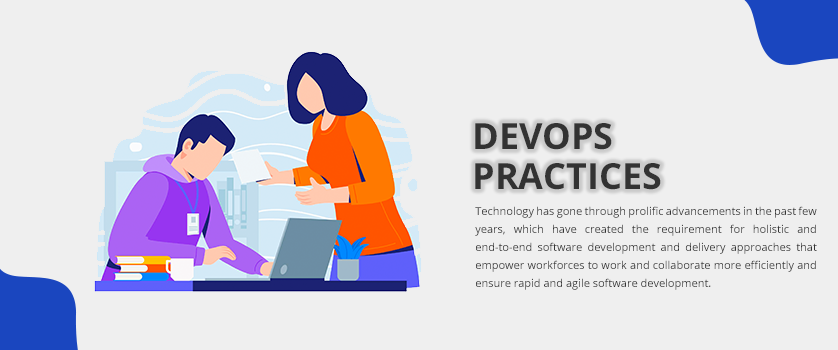


Technology has gone through prolific advancements in the past few years, which have created the requirement for holistic and end-to-end software development and delivery approaches that empower workforces to work and collaborate more efficiently and ensure rapid and agile software development. This requirement led to the introduction of a more collaborative and agile culture of software development by DevOps.
Today, enterprises rely on this technology to adapt to the increasing software velocity and throughputs generated through agile methods and remove siloes in software development processes.
But, what makes DevOps lifecycle different from the traditional software development life cycle?
To understand this, let us first have an overview of DevOps.
A game-changer in Information Technology, DevOps, initiated the digital transformation of the industry by optimizing development and operations activities through various practices such as structured processes, automation, and collaboration.
DevOps allowed organizations to keep up with the advancing world and frequently changing demands of customers and the market by enabling them to move away from siloed roles and processes and focus on synergizing the development and operations processes, making them more agile and efficient. Moreover, by incorporating automation, collaboration, Continuous Integration & Continuous Delivery, DevOps streamlined processes and made them more beneficial, rapid, iterative, and consistent.
Therefore, in this article, we will elaborate on these important practices of DevOps and highlight how they make software development more reliable, agile, and scalable.
DevOps Practices:
DevOps came into being to unify development and operations processes and meet the increasing demand for rapid and consistent software delivery without impacting its quality, performance, and functionality. Since then, the technology has helped organizations seize market opportunities faster and reduced the time required to include customer feedback.
Moreover, it initiated necessary cultural and organizational changes that led to the adoption of various new practices that further made software development reliable, scalable, and agile.
These practices are now at the core of successful DevOps implementation and are responsible for fostering proper setup of standardized structures, build, platforms, tools, processes, and guidelines. Furthermore, these practices encourage smoother and continuous communication, collaboration, integration, and transparency between application development and operations teams.
Hence, the core practices that constitute the DevOps culture are:
Continuous development relies on automated processes to increase the overall efficiency of the process and reduce the time and efforts required to deploy new software features accurately. It is one of the most efficient practices that help increase the team's productivity by allowing them to focus on necessary and priority tasks.
It is an important practice that facilitates collaboration between team members and allows them to share their code and unit tests by merging changes into a shared version control repository after each minor task is completed. Like continuous development, continuous integration also relies on automated tools to assert the new code’s correctness before integration. This helps eliminate integration risks and ensure the quality of the end product.
Hence, continuous testing is an integral part of DevOps as it helps speed up the delivery of the code to production and also involves version control for detecting integration problems in advance.
With the help of this process, teams can thoroughly validate updates and identify and address bugs and issues quicker. Moreover, it automates the entire software release process, which further helps improve developer productivity, reduce the number of errors, and prevents system anomalies.
Another major advantage of continuous deployment is that it uses a range of automated tools to make the process more agile, rapid, and consistent. A few of these popular automated tools are Chef, Puppet, Google Cloud Deployment Manager, and Azure Resource Manager.
With the help of Continuous Monitoring, organizations can perform real-time analysis and enhance transparency and visibility of IT and network operations. Furthermore, it helps track user behavior and allows teams to take necessary actions to meet user requirements.
Infrastructure represented as code can also be validated and tested to prevent common deployment issues and deliver stable environments rapidly and at scale. In short, Infrastructure as Code (IaC) is an essential part of DevOps that helps teams to work in cohesive and provide predictable, repeatable, and reliable software delivery services.
From build and testing to delivery and deployment, all DevOps practices are highly dependent on automation as it fosters speed, greater accuracy, consistency, reliability and increases the number of deliveries. Moreover, it helps organizations to bring isolated teams together, automate workflows, enhance monitoring, get rapid issue resolutions, and achieve faster time to market.
It is a form of operating system virtualization that allows developers to create and deploy applications faster and more securely. Moreover, Containers are lightweight, which means they can be executed in large numbers even on relatively limited machines.
Built around business capabilities, Microservices are therefore used to rapidly build new components of applications to meet changing business requirements and to make constant iteration and delivery (CI/CD) more seamless and achievable.
The importance of Version Control is immense in the DevOps lifecycle, as it helps achieve critical requirements like agile software delivery, reproducibility, and traceability, which further improves disaster recovery, capacity management, response to defect, and accomplish higher software quality.
In the past few years, organizations have significantly increased the application of DevOps and agile practices into their software development lifecycle, which has further gained momentum in the last years due to the COVID-19 pandemic. However, no matter the reason for DevOps implementation and application, it has resulted in improved quality of the end product and support, enhanced security, and accelerated time to market.
Hence, we can assume that in the coming years the adoption of DevOps culture will continue to accelerate and may even expand to integrate into post-deployment activities, like security checks and maintenance.